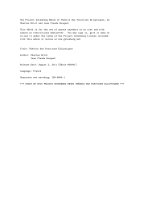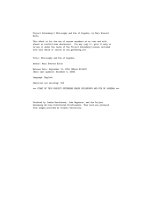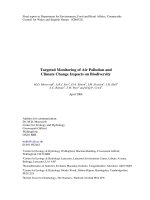Climate change-induced impact on water resource of Ladakh cold arid region
Bạn đang xem bản rút gọn của tài liệu. Xem và tải ngay bản đầy đủ của tài liệu tại đây (573.96 KB, 14 trang )
Int.J.Curr.Microbiol.App.Sci (2019) 8(5): 1996-2009
International Journal of Current Microbiology and Applied Sciences
ISSN: 2319-7706 Volume 8 Number 05 (2019)
Journal homepage:
Original Research Article
/>
Climate Change-Induced Impact on Water Resource of
Ladakh Cold Arid Region
Jigmet Yangchan1, M.S. Raghuvanshi2, Anil Kumar1* and C.K. Arya3
1
High Mountain Arid Agricultural Institute, Sher-E-Kashmir University of Agriculture Science
and Technology, Leh-Ladakh-194101 (J&K), India
2
ICAR-National Bureau of Soil Survey and Land Use Planning, Nagpur-440033
(Maharashtra), India
3
College of Horticulture & Forestry, (Agriculture University, Kota)-Jhalawar-326023
Rajasthan, India
*Corresponding author
ABSTRACT
Keywords
Water resources,
Ladakh region,
spring, Indus, Zing,
glacier
Article Info
Accepted:
17 April 2019
Available Online:
10 May 2019
This paper is about the impact of climate change on water resources, mainly focusing upon
the consequences of climate change on Ladakh people based on both qualitative and
quantitative approaches. Inadequacy of water resources, irregular rainfall pattern and
coping up under such scared water consequences are the major problems in the study area.
The main sources of water are glaciers, hand pump, stream and springs. Survey revealed
that almost 50% people responded on the impact of climate change; 30% responded due to
increase in population and consequently increased demand of water and remaining 20%
responded for no impact. Majority of them conveyed the Chem-Sak is water scared. As
60% Chem-sak people mentioned that quality and quantity of water are differed in last 25
years. People has observed the climatic hazards like cloudburst and flood, and facing
frequently. Finally, it was observed that the people started the adjusting with the changing
climate and need with available water resources over the last 25 years, confirming the
declining of water resources and their potential in fulfilling the demand of the Ladakhi
people as the risks are changing as a result of rapid climatic and socio-economic changes
due to groundwater vulnerability. On the other hand, climate change in Ladakh has
triggered the immediate melt water runoff and water supply is decreasing drastically.
Introduction
Ladakh region in Himalayan range is
characterized as excessive arid and severe
moisture deficit region throughout the year.
With scarce water resources, such regions
show high sensitivity and vulnerability to the
change in climate. Water is the vital resource
on which life sustains and water becomes
more valuable in this cold desert part of the
northernmost region of India, called Ladakh
which comprises of two districts, Leh and
Kargil. Groundwater since ancient times in
the form of springs provided ample water for
1996
Int.J.Curr.Microbiol.App.Sci (2019) 8(5): 1996-2009
the region and its contribution has increased
manifold in the wake of recent spurt in bore
well installations, especially, in Leh-Town
(Dolma et al., 2015). Ladakh which is
currently under arid and semiarid region is
likely to experience water stress conditions,
lack of soil moisture and water holding
capacity, and desert expansion. In general, the
linear decreasing pattern of precipitation.In
these last few years, it was visible in Ladakh
the impact of global climate change has been
increasing very rapidly. Rainfall pattern have
been changing, small glaciers and permanent
snow field are melting and temperature rise
has been affecting water runoff in the rivers.
In winter the snow pattern shift to Feb and
March by in less quantity. It clearly indicates
erratic behavior of precipitation in Ladakh in
last few years. Khardung Pass which used to
be completely covered by a layer of thick
snow about 4 meters (in July) until 1995 is
witnessing new predicament. The Pass has no
snow or less snow in year 2017.
Climate Change (CC) is a significant and
lasting change in the statistical distribution of
weather patterns over periods ranging from
decades to millions of years (Tiwari et al,
2015). So climate change is caused by
different reasons. It may be a change in
average weather conditions or in the
distribution of weather around the average
conditions (i.e., more or fewer extreme
weather events). Climate change is closely
related in all the sectors (Kankia, 2012)
highlights that, “Climate change is caused by
factors that include oceanic processes (such as
oceanic circulation), variations in solar
radiation received by Earth, plate tectonics
and volcanic eruptions, and human-induced
alterations of the natural world; these latter
effects are currently causing global warming,
and "climate change" is often used to describe
human-specific
impacts”.
Watershed
Planning, 2008 states that, Even greater
changes are expected in the future, including
a continued rise in temperatures, shifts in
rainfall patterns, and increases in certain types
of hazardous weather, such as heavy spring
rains and heat waves” (HeW, 2012).
Description of the study area
Survey was carried out to study the impact of
climate change on water resources and
livelihood of Ladakh region. A case study of
Chemday village panchayat was taken for the
study, located in eastern part of Leh valley
with
geo-coordinate
latitude
34.09N,
longitude 74.79E; 3543 m altitude and
adjoining villages are Egu, Gia, Kharu,
Martsaylang, Sakti, Shara. The main objective
behind identifying Chemday village is located
in a valley which is supported by 3 sidedglacier streams and large number of water
bodies in the form glacier streams, handpump, spring water on which people
(household-300) survive in the lap of ChangLa glaciers. On the other hand, people
mentioned the shortage of irrigation water for
their annual but mono-cropping based
subsistence agriculture they highly depend on
Changla glaciers and Warila for irrigation
purpose and also using hand pumps and
spring water for drinking purpose.
( />
Major objectives of the study site is to explore
the status of water availability and impact of
climate change on water resources/ bodies in
context to understand the present scenario of
1997
Int.J.Curr.Microbiol.App.Sci (2019) 8(5): 1996-2009
water availability and is a climate change
affect on water resource of Chemday.
Climate change and water resources in
study area
There is uncertainty surrounding the
vulnerability of Ladakh to long-term climate
change. Changes to temperature and winter
snowfall are fundamental to water
availability; this may increase melt water
runoff, while decreasing water supply in the
long term. Annual climatic changes are
extreme (Le Masson 2013), with large
temperature swings between summer and
winter. Property is divided according to
agricultural requirements. Villages have
traditional and complex techniques for
channeling irrigation; water is allocated by
village and household, and if scarce, mediated
by the chhu-pon (Lord of water), an elected
village official. The high value and insecurity
of water can make distribution, a much
politicized issue (Angchok and Singh 2006).
The Trans-Himalayan region of India consists
of Cold deserts of Ladakh and Himachal
Pradesh. Valleys in these regions have highest
permanent villages; receiving annual rainfall
of only 100-140 mm. A total of 97.5% of all
the water on Earth is saltwater, leaving only
the remaining 2.5% as freshwater and
approximately 70% of the freshwater
available on the planet is frozen in the icecaps
of Antarctica and Greenland” (Govt. of Nepal
(2011).
Also the paper highlights that, this leaves only
the remaining 0.7% of the total water
resources worldwide accessible for direct
human uses. And this water is found in lakes,
rivers, reservoirs and those underground
sources that are shallow enough to be tapped
at an affordable cost. This also is the only
amount that is regularly renewed by rain and
snowfall and therefore available on a
sustainable basis.
Khan (2010) reported that, “Climate Change
refers to the variation in the Earth’s global
climate or in regional climate over time”.
Rinchen Norbu Wangchuk (2018) revealed
that the most critical impacts of climate
change in Ladakh are related to increase in
tourism
and
hydropower
generation,
stemming from glacier retreat, expansion of
glacial lakes, and changes in seasonally and
intensity of perception.
Materials and Methods
The main essence of this study is to explore
the overall situation of water resources and its
impact on the people that are using the
resources and its water quality. For this study
report we have conducted survey research to
get the information regarding climate change
and its impact on water resources. The
research was conducted within the HMAARI
SKUAST-K Leh. We conducted the survey
research study in different area of Chemday,
Sakti (chem.-sak) and Kharu. We did the
survey research through purposive sampling.
There were 10 respondents in the survey
regarding the climate change and its impact
on resources.
The methodological process is both
qualitative and quantitative. In quantitative,
survey questionnaire were prepared and filled
up. But in qualitative case, interview and
observation in three places were done. Some
of data’s are described and analyzed and some
of them are transcribed and interpreted. The
meanings are generated and analyzed in the
narrative and descriptive forms.
Results and Discussion
The survey was conducted in the study area
and different water resources management,
peoples’ contribution and water quality
scenario with passing time etc. are presented
in this section.
1998
Int.J.Curr.Microbiol.App.Sci (2019) 8(5): 1996-2009
Water resources management in cold arid
regions
Geo-Climatic Conditions
Region of strategic defense importance
Snow bound rugged terrain with very meager
natural vegetation
Remains landlocked during winters
Less oxygen availability with low humidity
(20-47 %)
Temperature ranges from - 350C to +350C
Precipitation as snow i.e. 9 cm (Leh) & 24 cm
(Kargil)
Average wind speed: 70 nautical mile /hr
Short agricultural season (May-Sept)
Fragile ecosystem
Sources of irrigation water
In the hill region, the scope of boring
tubewells, canals and even lift irrigation is
limited, such facilities are confined to the low
laying areas. Therefore, the most common
source of irrigation remains the small water
channels locally called Kuhls which intact
accounts for 85.83 per cent of the total area
under irrigation in hills
In cold deserts, some villages get water for
irrigating their lands from some perennial
torrents. In Spiti valley, the source of
irrigation water is generally local nallas.
Glacial water in cold deserts of Himachal
Pradesh which forms the prime source of
sustaining life in the region is brought to the
field by making Kuhls (Water Channels).
In Kinnaur and other regions, the source of
irrigation as well as drinking water is melting
snow on the high peaks which runs downward
in the shape of small and big nallahas
(streams) and also spring out at certain points.
In cold deserts, some villages get water for
irrigating their lands from some perennial
torrents. In Spiti valley, the source of
irrigation water is generally local nallas.
Glacial water in cold deserts of Himachal
Pradesh which forms the prime source of
sustaining life in the region is brought to the
field by making Kuhls (Water Channels).
In Kinnaur and other regions, the source of
irrigation as well as drinking water is melting
snow on the high peaks which runs downward
in the shape of small and big nallahas
(streams) and also spring out at certain points.
Utilization pattern of available water has
tremendously changed if compared with past
decades. Even local people have started
consuming more water than what they used to
do a decade ago. It is confirmed that weather
is getting warmer, forcing people to increase
their frequency of different utilization pattern
in the light of temperature in Ladakh
increased by 3°C between 1973 and 2008,
while in the rest of India it increased by only
1°C as per Intergovernmental Panel on
Climate Change. With the glacier on which
Leh depends is likely to melt completely in
the next five to six years, the demand for
water is predicted to grow to 6 million litres
by 2019 and volume of precipitation
witnessing a southward trend, visitors to
Ladakh has to act responsibly and reduce
water usage.
Ground water varies due to large variation in
topography. Depth of water is shallow in
valley and deeper in the hilly areas of Ladakh
region. Depth of water ranges from 1.3 m in
Zorawar fort to 43.36 m below ground level
in ITBP sites. Springs are the main source of
water supply for domestic purposes and also
serve for irrigation of crops. It marks the
prominent seepage/ contact zone valley fill
deposit with older formations and weak zone.
Constraints and strategies for sustainable
livelihood
Low vegetation
Less oxygen concentration
Acute mountain sickness
1999
Int.J.Curr.Microbiol.App.Sci (2019) 8(5): 1996-2009
Sleep disturbances
Reduced physical efficiency
Prone to frostbite
Chilling Zing
Reduced fresh food availability (Oct-April)
Fragile ecosystem
Remoteness and landlocked
Stakmo zing
Facilities extended by LAHDC for
drinking water and other uses where
no facilities available in Leh city
High altitude remote regions like Ladakh
have many constraints under cold arid region
however simultaneously administration has
developed strategies for enhancing runoff
(Phuntsog et al., 2017). Constraints identified
are low and erratic rainfall, highly permeable
sandy terrain, high evaporative demand, deep
and generally saline groundwater, target
oriented development of water resources,
poor socio-economic condition of local
population, lack of education, reduced
snowfall with 21% decrease glacierized area
IHR (WWF, 2010) with glaciers less than 1
metre square retreating faster, higher
dependency on natural resources, low receipt
coincides with high demand pattern etc.
Artificial glacier
Possible strategies are techniques for
enhancing runoff from catchments, traditional
structure under practice in Ladakh is locally
known as Zing which are small tanks, in
which collects melted glacier water (Sharma
and Mir, 2000), snow management is an
important practice and source of irrigation
water in cold arid regions but declining
glacier recharge by 21 per cent has recently
threatened few villages where sowing and
irrigation has been seriously been affected.
This is all due to changing climate. Winters
are getting shorter with more increasing
number of rainy days but less precipitation
under dry windy nature. The artificial glaciers
have been innovated and located as far as
possible closer to the village and at lower
altitude so that it starts to melt much earlier as
compared to a natural glacier i.e. in the month
of April – May so as to supplement with
additional irrigation water. During the winter
months of November – December, the
channel is built which divert/ guide the runoff
Region is a dry land with difficult farming,
and entire area depends on irrigation due to
prevailing soil conditions and melting water
from the glaciers through long, winding
streams from upper mountain reaches. Melted
water was the only source of irrigation for 80
percent of the villagers in Ladakh, where
water is diverted to guiding channels and
taken to a small tank-traditionally called
ZING and distributed with the help of water
manager Chhurpan. However, in recent times,
decreased, scanty and untimely snowfall,
retreating glaciers had an impact on domestic
and agricultural needs.
2000
Int.J.Curr.Microbiol.App.Sci (2019) 8(5): 1996-2009
water to the shady side of the mountain where
it can slow down and freeze. On the other
hand, due to short summer, mono-cropping is
practiced from crucial month of April or May
till September. Missing sowing at appropriate
timing reduces yield by 50 per cent.
60% Chem-sak people mentioned that quality
of water deceasing every year so rapidly and
35 % peoples were not sure about changes.
Data analysis and interpretation
As per analysis of data collected through
survey, it was observed that there has been
change in quality as well as source of water
also. Similarly the respondents said that there
is declination in quality and quantity of water
with time.
The data collected from the survey is an
interpreted and analyzed. There are both
qualitative and quantitative data. Both the
data sources are analyzed and interpreted as
follows:
Present Scenario of water availability in
Chem-Sak
According to the survey done in Chemday,
Sakti, Kharu, almost 55% said that they have
insufficient water. Remaining 45% mentioned
that they have sufficient water. The figure 1
shows that present scenario of water
availability in Chem-sak is in sufficient.
Sources of water
The sources of water using by the people of
Chem-Sak are analyzed and shown in Figure
2. In Chem-Sak village around 300 hand
pumps were bored. As such no pipe lines exist
in Chemday Sakti village. 70% people depend
upon hand pump for drinking purpose.
Almost 15% depend upon stream water.
Remaining 5% depend upon spring water for
drinking water.
Changes observed in water quality
There are various sources of water that people
of Chem-Sak are using. Water quality and
sources of water are also changed with time.
Quality of water has been analyzed and
mention below in Figure 3.
It is observed from the figure that the quality
of water is changing with passing time. As
Reason behind the changes in water quality
and quantity
Regarding change in water quality, 80%
people reported about increased tourism
population and labors. Existence of toilet at
Changla Top and Zingral (Warila) is in a very
filthy and bad condition which is maintained
by the army and local govt. There is a
desperate need for a public convenience at
Changla as it is the main water source for the
people of Chem-sak, Kharu. The present
condition is really pathetic and polluting the
water source. Some10% people said stream is
far and not fit for drinking but the hand pump
quality also decreased due to high Total
Dissolve Solids. Remaining 10% said that our
spring got dried due to excessive discharge by
army hence quantity and quality also decrease
(Fig. 4).
Reason behind water scarcity
Chem-sak people mentioned that their village
falls under water scarcity zone. Among the
respondents 70% said water scarcity due to
climate change and due to less snowfall as
compare to time with 20-25 years back. Some
30% people said that it is due to improper
management of water (Fig. 5).
Change in water resources
The figure 6 shows that major people has
changed their water sources. It shows that the
number of people who change the source of
2001
Int.J.Curr.Microbiol.App.Sci (2019) 8(5): 1996-2009
water is 65% and 30% still using same source
of water and remaining 5% use both.
Reason behind the change in water sources
As per analysis and also through this chart, it
is shown that 45% people changing water
sources due to increase in water pollution in
stream, 20% due to long distance and 15%
people changed their source of water because
they get water at home through hand pump.
As such no pipe line were installed in this
village. Remaining 20% is still using the same
source of water (Fig. 7).
Distance of Carrying Water
The above figure 8 gives the distance of
carrying water. Total of 65% peoples said that
to fetch water its take around 15 minutes to
cover the distance, 30% said that to fetch
water its take around 1/2 hr to 1hr to cover the
distance and 5% people due to availability of
hand pumps at home so only 0-5minutes
distance to cover.
Management of water resources
The equal distribution of water resources for
irrigation in this village is done by Churpon,
head of water association. Churpon is the
representative of whole village elected by the
Chem-sak people. His responsibility is to
make planning, execute the plan, and
monitoring the plan to achieve equal
distribution of water to each piece of
agricultural land throughout whole season.
Water for irrigation
This part of information is about how the
people irrigate their field. Whether the water
is sufficient for irrigation or not? Also it helps
to analyze the sources of water for irrigation
and mentioned in Figure 9. Above given
figure says that Maximum 85% people
depend upon stream water for irrigation. In
some season, people face the problem of
insufficient irrigation water due to lack or less
snowfall occurs in winter. 10% people depend
upon hand pump during April-May for their
nursery rising when proper ice melting is not
happen. Remaining 5% people who are near
to spring also used that water for nursery
rising and vegetable growing when initial
irrigation is must.
Sufficient water for irrigation
Regarding the sufficient of water for
irrigation, 80% chem.-sak people reported
that the water is not sufficient for their crop.
After 10-12 days interval they get irrigation
for the crop. Few farmers, who grow cash
crop, have to irrigate their field through hand
pump because of insufficient water
availability which affects the crop yield. 20%
said that they don’t face water crises because
they are at upstream site (Fig. 10).
Climate changing
The trend of increasing climate change in the
last 25 years in the Chem-Sak area is shown
in Figure 11. We discussed with people of
Chem-Sak about the climate change over the
last 25 years. Most of the people i.e. 50% said
that they are feeling climate change, 30% said
that climate change is increasing with
increase in population and the demand.
Remaining 20% said that they didn’t feel any
change.
Increase in dry periods
Regarding our question about whether there is
increase in dry period or not we come to
know that almost 68% people said that they
are facing the dry periods (Fig. 12).
Remaining 32% said that they don’t have any
idea about the increase in dry period.
Increase in climatic hazards
About our queries regarding the increase in
2002
Int.J.Curr.Microbiol.App.Sci (2019) 8(5): 1996-2009
climatic hazards, it is found that 80% people
were agree with increase in climatic hazards,
20% said that people crop hazard is increase
due to climatic hazards. 0-1% said that they
are not aware about these things.
Types of climatic hazards
Gathering information towards the different
climatic hazards given in figure 13 which
shows that maximum chemsak people said
that flood/ cloud brust is the main climatic
hazards that they are facing in last few years.
Same time due to lack or less snow fall they
face some year drought problem also due to
water scarcity.
Impact of climatic hazards on water
As the study was undertaken to know the
impact of climate change on water resources
in context to climate hazards, 75% said that
there is impact of climatic hazards on water
resources, 35% said that climatic hazards are
not the causes for bringing any change in
water resources and 0-1% people have not
any idea regarding this issue (Fig. 14).
Fig.1
Fig.2
2003
Int.J.Curr.Microbiol.App.Sci (2019) 8(5): 1996-2009
Fig.3
Fig.4
Fig.5
2004
Int.J.Curr.Microbiol.App.Sci (2019) 8(5): 1996-2009
Fig.6
Fig.7
Fig.8
2005
Int.J.Curr.Microbiol.App.Sci (2019) 8(5): 1996-2009
Fig.9
Fig.10
Fig.11
2006
Int.J.Curr.Microbiol.App.Sci (2019) 8(5): 1996-2009
Fig.12
Fig.13
Fig.14
2007
Int.J.Curr.Microbiol.App.Sci (2019) 8(5): 1996-2009
Findings
Climate change has been taken as a global
problem. In the same way, the Chem-sak
people also have told that climate change has
great impact on water resources and other
natural resources. If the timely information is
not provided, there may be great
consequences. Some of the major findings are
given below.
The majority of 55% Chem-Sak people
mention lack of water resources however
45% said sufficient water.
Mainly facing water scarcity during initial
irrigation due to spring season as well as
when less snowfall in winter.
Hand pumps, stream, springs are the main
source of water. 300 handpumps are bore
in Chem-Sak and 70% using this water
sources.20% still fetch water from
stream. Remaining 10% depend on
spring.
Quality of water is decreasing with time.
Majority of people(80%) said that quality of
water decrease due to increase in tourism
population and labours at upstream site
of mountain.10% said decrease in water
quality due to high TDS in handpump
water.
65% of people have been changing source of
water.35% still using same source of
water. Remaining 5% using both.
Maximum Distance covered to fetch the water
take 1/2 to 1 hr when fetch water from
stream.. Minimum time taken 0-5mt if
hand pump was located near to home.
Churpon is the representative of all villagers.
His responsibility to plan, executes, and
monitors proper and equal distribution of
water throughout the year.
Stream is main source of water for irrigation
85-90% people depend on steam
water.10% people use handpump water
for nursery raising in springs. Remaining
10% used spring water for vegetable
growing and nursery raising if it near to
resident.
The majority of respondents (80%)
announced that Chem-Sak fall under
water scaracity village.
Climate is getting warmer over last 25
years.20% said have no idea of such
condition.
Increased dry period is experienced by 68%
of Chem-sak people. Remaining 32%
have no idea about such issue.
Chem-Sak faced climatic hazard (80%)
Flood/cloud brust is the main climatic hazard,
drought are other climatic hazard in the
area.
The impact of hazard on water resources is
more experienced.
The study about Chem-sak village in Ladakh
region revealed that people have been facing
effect of climate change such as decreased in
source of water, long dry-windy season,
possibility of flood and drought every year.
This is just the initial sign for great disaster of
future. Chem-Sak is a big village. Maximum
tourist passes through this village to Pangong
lake. With increase in frequency of tourism
via this village including Army camps at
Warila enhancing the imbalance in natural
resources. As already 300 numbers of handpumps exist till date and people exploiting
ground water also. Meantime springs also get
dried due to heavy extraction of groundwater
by army. It’s all because we are polluting our
surface water that is stream water. If it is not
stopped then in future it become very
alarming situation for adjoining villages
especially Chem-Sak to get access to
utilizable portion of water.
It may be recommended that
Frequently cleaning of stream, mountain,
spring, hand-pump areas from pollution.
Stop and make prohibit area for cloth washing
2008
Int.J.Curr.Microbiol.App.Sci (2019) 8(5): 1996-2009
Climate change awareness through campaign
or their program should be conducted.
Strictly prohibit the hand-pumps sanction;
Proper measures should be taken to manage
tourists keeping them away from sacred
water resources.
Detailed investigation is required to explore
saving the potential water resources;
Government agencies should pay attention to
preserve Changla and Warila glaciers for
conserve, Chemday, Sakti, Kharu,
natural resources.
References
Agrawal, S., Raksakulthai, V., Aalst, M. N.,
Larsen,
P
and
Smith,
J
(2003). Development and climate change
in Nepal: Focus on water resources and
hydropower pp. 16-42.
Angchok, D and Singh, S. (2006). Traditional
irrigation and water distribution system in
Ladakh. Indian Journal of Traditional
Knowledge, 5(3) pp.397-402.
Dolma, K., Rishi, M.S and Lata, R. (2015). An
appraisal of centralized waste water
treatment plant with respect to Leh
town. International Journal of Science
and Research, 4(5), 754-759.
Government of Nepal (2011). Water Resources
of Nepal in the context of climate change.
He, W (2012). An Evaluation of prairie
producer attitudes towards Climate
Change. Unpublished Master’s Thesis.
University of Saskatchewa.
Kankia,
N.A
(2012). Environment
and
sustainable development. Journal of
educational and social research 2:140143.
Karthikeyan and Hemalatha (2018) Kashmir:
Melting glaciers threaten Ladakh's nature.
/>es/kashmir-melting-glaciers-threatenladakh-nature-180513080600731.html
Khan, S.A (2010). Global warming and climate
change. New Delhi: RVS Books.
Ladakh Autonomus Hill Development Council
(LAHDC) 2005.Ladakh 2025 vision
document, LAHDC, Leh Ladakh.
Norbu, R and Wangchuk (2018). Ladakh facing
its worst water crisis ever: How its can
effectively tackle climate change.
/>nchen-norbu-wangchuk.
Parajuli, R (2010). Climate Change and local
impacts-synergy between adaptation and
renewable energy development for Nepal
1-29.
Sharma, J.P and Mir, A.A. (2000). Dynamics of
cold arid agriculture. Kalyani publisher,
New Delhi, India
Tiwari, D.P and Nayak, H.C (2015). Climate
change and its impact on global health.
International Journal of Recent Research
in Interdisciplinary Science. 2:29-38.
Tundup, P.,Wani, M.A., Dawa,S., Hussain, S
and Laskit, J (2017). Water harvesting
and conservation under cold desert
condition of Ladakh (J&K): constraints
and
strategies.
Int.J.Curr.
Microbiol.App.Sci. 6(2): 1796-1800.
/> />rt-column/ladakh-water-scenario/
How to cite this article:
Jigmet Yangchan, M.S. Raghuvanshi, Anil Kumar and Arya, C.K. 2019. Climate ChangeInduced Impact on Water Resource of Ladakh Cold Arid Region. Int.J.Curr.Microbiol.App.Sci.
8(05): 1996-2009. doi: />
2009









